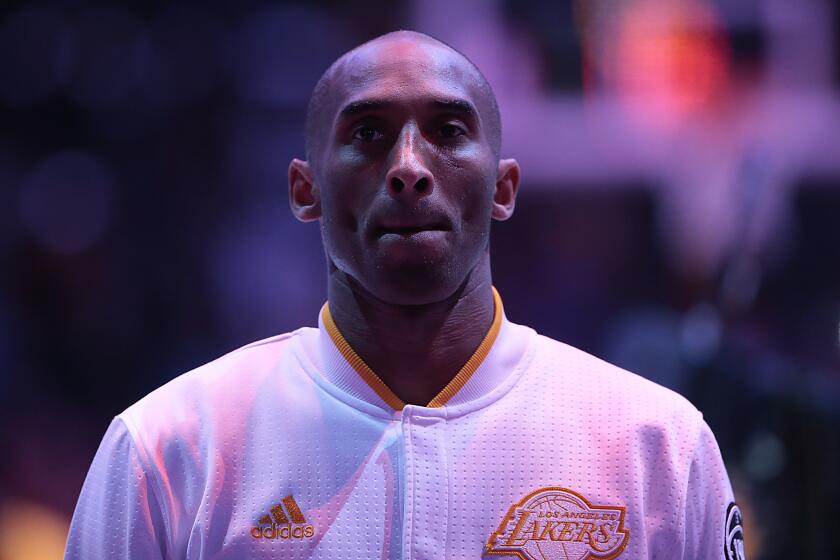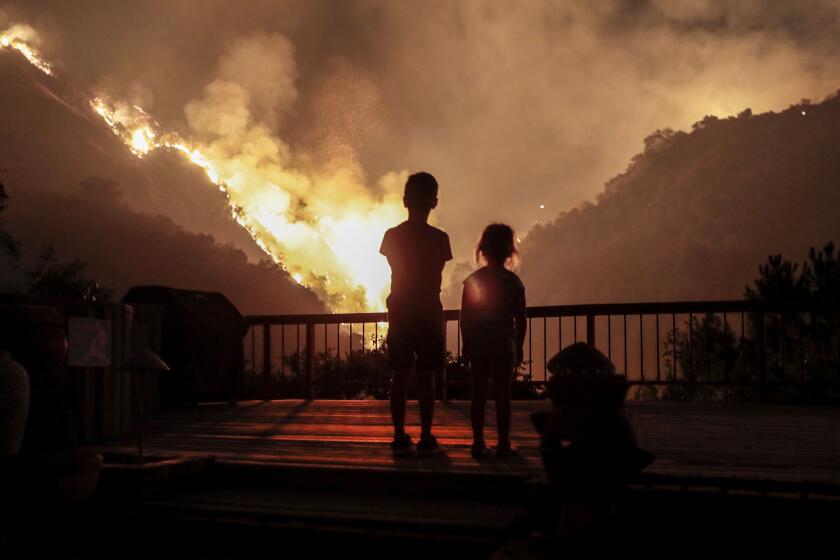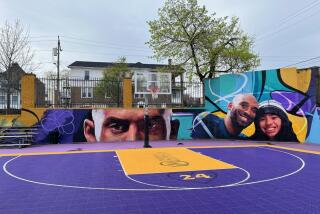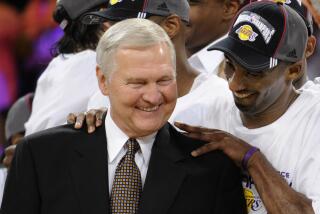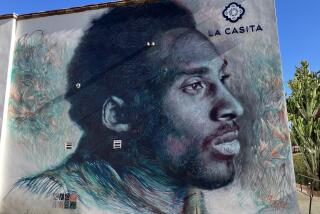
- Share via
First in a series of Times Sports stories looking at the some of the biggest sports moments and storylines of 2020.
A melancholy sky settled over Los Angeles that morning, the weather cool and gray north of downtown, almost to county line. I had been on the Ventura Freeway only a few minutes when news came over the radio, the first report of a helicopter crash above Calabasas. I couldn’t help looking as I drove past, as if there might be a glimmer of fire or black smoke in the distance, something to mark the spot, to mark the moment, but the hills were shrouded in mist.
Somewhere up there, Kobe Bryant had died.
It was the sort of thing that can put you off-balance, the loss of someone larger-than-life, a fixture in our city. I soon arrived at a school gymnasium that should have been humming with excitement, kids ready to play, parents chatting. The place was quieter than usual, everyone bent over cellphones, reading.
Soft words ruffled through the air, whispers, variations on a similar theme. Did you see the latest? His daughter was with him.
Details trickled in, the sort of tidbits that cannot quite make sense of the situation. The 41-year-old former Laker was taking his 13-year-old daughter, Gianna, from their Newport Beach home to a youth basketball tournament in Thousand Oaks where he was going to coach her team. Others were in the helicopter, a teammate and parents, another coach. Nine people in all.

L.A. mourns the death of Lakers legend Kobe Bryant.
Shortly before 10 a.m., the pilot became disoriented in dense fog, the helicopter losing altitude, slamming into a hillside of tall grass and brush. Los Angeles County firefighters reached the scene to find wreckage and flames, no survivors. As a dull shock came over the nation, if not the world, Southern California took it especially hard, friends texting each other and people setting basketballs outside their front doors in tribute.
Fans gravitated to Staples Center as if by instinct, fashioning a memorial of flowers and prayer candles. “This is a day I’ll never forget,” said a man who brought a painting of Bryant. “It’s bigger than basketball.”
The death of a celebrity can shake our grasp on the universe, as if talent and wealth should make a person immune to tragedy. It might be hard to recall now, but the early weeks of 2020 were a more-innocent time — in sports and everywhere — before we knew what true hardship looks like.
Complete coverage of the death of Kobe Bryant, his daughter, Gianna, and seven others in a helicopter crash.
I was called back home on that afternoon of Jan. 26 to pour over facts and dates, working with a colleague on Bryant’s obituary, no time to parse greater meanings. Not until later did I begin to understand.
It was 1996 when Bryant hit Los Angeles like a lightning bolt, a gangly 6-foot-6 teenager jumping from high school to the NBA. Paired with the newly arrived Shaquille O’Neal, he embodied the Lakers’ salvation. “I know it’s a big step,” the rookie said, flashing his trademark confidence. “I know I can do it.”
Kobe Bryant, the coronavirus, social justice, wildfires and one of the most contentious elections in American history.
Blurry fast moves to the basket, last-second jump shots, scoring records and Olympic gold medals — Bryant dazzled with sheer talent. Lakers great Jerry West said: “Just to see the joy he played the game with, the joy he brought to fans, was pretty remarkable.”
But if Bryant’s path to stardom felt preordained, it was rocky. Even as he helped the Lakers to a championship threepeat in the early 2000s, the spotlight’s glare illuminated lesser angels of his life.
The massive O’Neal was the lovable half of the duo, a big goofy kid, grinning and joking. Bryant, by contrast, could be alternately charming and petulant, sitting at the back of the team bus with headphones clamped over his ears. It was a difficult spot for a young man who had brought his parents to live with him when he first joined the NBA. The truth was, we were watching him grow up.
When he bickered with O’Neal, when the team traded its lovable center, Bryant got the blame. In 2003, he was accused of raping a hotel employee while visiting Colorado for knee surgery. Though his accuser ultimately decided not to go forward with a criminal trial, Bryant lost millions in endorsements; many people neither forgave nor forgot as the media focused on a $4-million purple diamond ring he bought for his wife, Vanessa, and speculated about a potential divorce.

We lived through each thrill and disappointment of this very public life. As his career stretched across 20 polarizing years — all the bright and ugly, all in purple-and-gold — Bryant became part of the family. A bratty little brother, a favorite cousin.
The team won two more NBA titles before age began to erode his skills and maturity softened those hard edges. After his final game in 2016, after he scored an improbable 60 points against the Utah Jazz, Bryant spoke to the city from center court. “We’ve been through our ups and been through our downs,” he said. “I think the most important part is that we all stayed together throughout.”
The Bryant we knew after basketball seemed to smile more often, laughing at himself, making peace with O’Neal. The scope of his fame widened to encompass an Oscar for the animated short, “Dear Basketball,” a series of children’s books and a growing business empire. More importantly, we saw him as a father, a guy who picked up his girls from school and always put the toilet seat down in a houseful of women.
Not that everyone shuttles their kids to youth games by private helicopter, but he died in a way that hit close to home. We’ve all been at the wheel or in the backseat of the family car on that trip, heading to a ball field or recital or science fair. The fact that Gianna sat beside him made it so common, so relatable, so desperately personal.

Twenty-thousand people filled Staples Center for a nationally televised memorial that began with a song from Beyonce, followed by tearful eulogies from O’Neal and Michael Jordan. Vanessa described her late husband as a true “girl dad,” while fans who could not get tickets lingered outside.
“I don’t know if the numbness will ever go away for L.A.,” said a man who came with his mother. “At first, people thought that maybe they are wrong. Maybe Kobe isn’t dead. Today really brings home the reality.”
That week, public health officials continued to sound the alarm about a mysterious virus emanating from China, but there were only scattered COVID-19 cases nationwide. The year 2020 had just begun and, mourning the death of a superstar — our superstar — we thought things could not get any worse.
Part 2: How COVID-19 and the NBA’s abrupt shutdown brought the sports world to a halt.
More to Read
Go beyond the scoreboard
Get the latest on L.A.'s teams in the daily Sports Report newsletter.
You may occasionally receive promotional content from the Los Angeles Times.

